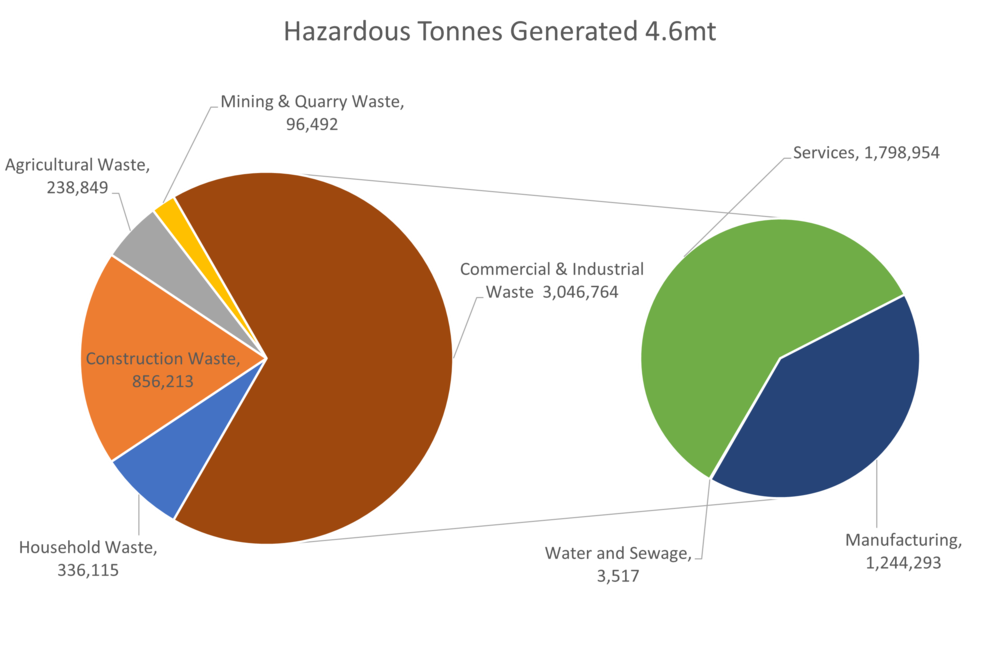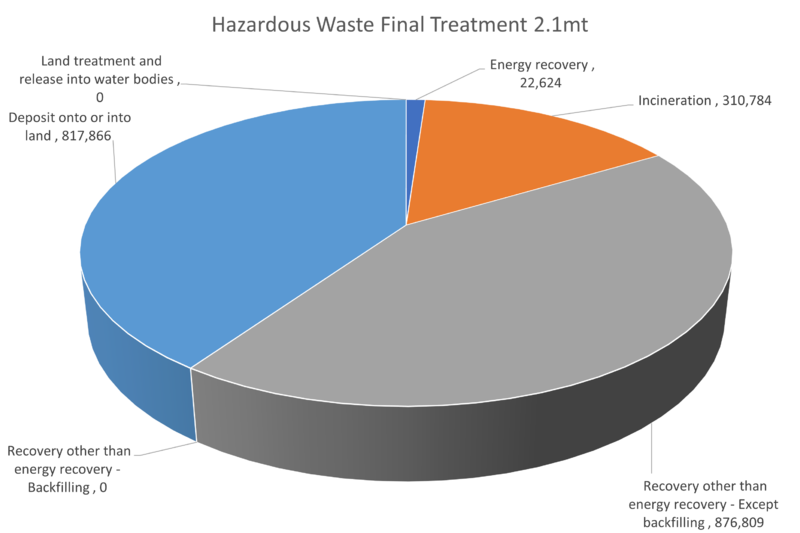Hazardous Waste: Difference between revisions
Imported from text file |
mNo edit summary |
||
| (14 intermediate revisions by 4 users not shown) | |||
| Line 1: | Line 1: | ||
Hazardous Waste is waste that appears in the List of Waste (England) Regulations 2005, as amended as a six digit code with an asterisk e.g.16 06 01*. Wastes are generally hazardous if they contain or exhibit properties which are hazardous to human health or the environment e.g. toxic, corrosive, mutagenic etc. Hazardous | [[Category:Tonnage & Waste Types]] | ||
[[Hazardous Waste]] is defined within Art 3(2) of the [[Waste Framework Directive]] ([[WFD]]) as waste which displays one or more of the hazardous properties listed in Annex III (of the [[WFD]]). [[Hazardous Waste]] is listed in the [[European Waste Catalogue]] ([[EWC]]) as a six digit code with an asterisk (*) e.g. 07 04 01*. | |||
==Overview== | |||
[[Hazardous Waste]] is defined within Art 3(2) of the [[Waste Framework Directive]] ([[WFD]]) as waste which displays one or more of the hazardous properties listed in Annex III (of the [[WFD]]). [[Hazardous Waste]] is listed in the [[European Waste Catalogue]] ([[EWC]]) as a six digit code with an asterisk (*) e.g. 07 04 01*. | |||
Examples of [[Hazardous Waste|hazardous waste]] as listed in the [[EWC]] are outlined in the table below (with the 2-digit code being the Chapter Title and the 4-digit code being the process giving rise to the [[waste]]): | |||
{| class="wikitable" | |||
|- | |||
! [[EWC]] !! Description!![[STAT]] Group | |||
|- | |||
| '''13 || '''OIL WASTES AND WASTES OF LIQUID FUELS (except edible oils and those in chapters 05, 12 & 19)'''|| | |||
|- | |||
| '''13 01 || '''waste hydraulic oils'''|| Used Oils | |||
|- | |||
| 13 01 01* || hydraulic oils, contianing PCBs||Waste Containing PCBs | |||
|- | |||
|13 01 04* || chlorinated emulsions|| Used Oils | |||
|- | |||
|13 01 11* || synthetic hydraulic oils|| Used Oils | |||
|} | |||
{| class="wikitable" | |||
When considering the diagram below of [[Hazardous Waste|hazardous waste]] waste arisings of 4.6 million tonnes in 2018, 80% of hazardous waste was grouped into the following [[STAT]] groupings: | |||
*Discarded Vehicles 23% | |||
*Chemical Wastes 21% | |||
*Discarded Equipment 10% | |||
*Mineral Waste from Construction and Demolition 10% | |||
*Used Oils 8% | |||
*Soils 8% | |||
==Hazardous Waste Arisings== | |||
The macro-level data reported in July 2020 by [[DEFRA]]<ref>[https://www.gov.uk/government/statistics/uk-waste-data UK Statistics on Waste July 2020 update]</ref> for tonnage arisings is summarised in the figure below, with a total of 4.6 million tonnes of [[Hazardous Waste]] arising in the UK in 2018: | |||
[[File:Picture2macrohazwaste2019.png|1000px|center|Macro Hazardous Waste Arisings 2018]] | |||
==Waste Listing== | |||
Hazardous Waste is waste that appears in the [[List of Waste (England) Regulations 2005]], as amended, as a six-digit [[EWC]] code with an asterisk e.g.16 06 01*. Wastes are generally hazardous if they contain or exhibit properties which are hazardous to human health or the environment e.g. toxic, corrosive, mutagenic etc ([[Hazardous Properties]]). | |||
==Treatment== | |||
Hazardous Waste requires specialist handling and treatment as defined within the [[Waste Framework Directive]] (2008/98/EC) and is regulated by the [[Hazardous Waste (England and Wales) Regulations 2005]] in England and Wales and by [[The Special Waste Regulations 1996]] and [[The Special Waste Amendment (Scotland) Regulations 2004]] in Scotland. The same macro level data reported in July 2020 showed the final treatment tonnage of 2.1 million tonnes was via the following destinations: | |||
[[File:Picture3macrohazwastetreat2018.png|800px|center|Macro Waste Final Treatment of Hazardous Waste in UK 2018]] | |||
==References== | |||
Latest revision as of 09:58, 12 July 2022
Hazardous Waste is defined within Art 3(2) of the Waste Framework Directive (WFD) as waste which displays one or more of the hazardous properties listed in Annex III (of the WFD). Hazardous Waste is listed in the European Waste Catalogue (EWC) as a six digit code with an asterisk (*) e.g. 07 04 01*.
Overview
Hazardous Waste is defined within Art 3(2) of the Waste Framework Directive (WFD) as waste which displays one or more of the hazardous properties listed in Annex III (of the WFD). Hazardous Waste is listed in the European Waste Catalogue (EWC) as a six digit code with an asterisk (*) e.g. 07 04 01*.
Examples of hazardous waste as listed in the EWC are outlined in the table below (with the 2-digit code being the Chapter Title and the 4-digit code being the process giving rise to the waste):
| EWC | Description | STAT Group |
|---|---|---|
| 13 | OIL WASTES AND WASTES OF LIQUID FUELS (except edible oils and those in chapters 05, 12 & 19) | |
| 13 01 | waste hydraulic oils | Used Oils |
| 13 01 01* | hydraulic oils, contianing PCBs | Waste Containing PCBs |
| 13 01 04* | chlorinated emulsions | Used Oils |
| 13 01 11* | synthetic hydraulic oils | Used Oils |
- Discarded Vehicles 23%
- Chemical Wastes 21%
- Discarded Equipment 10%
- Mineral Waste from Construction and Demolition 10%
- Used Oils 8%
- Soils 8%
Hazardous Waste Arisings
The macro-level data reported in July 2020 by DEFRA[1] for tonnage arisings is summarised in the figure below, with a total of 4.6 million tonnes of Hazardous Waste arising in the UK in 2018:

Waste Listing
Hazardous Waste is waste that appears in the List of Waste (England) Regulations 2005, as amended, as a six-digit EWC code with an asterisk e.g.16 06 01*. Wastes are generally hazardous if they contain or exhibit properties which are hazardous to human health or the environment e.g. toxic, corrosive, mutagenic etc (Hazardous Properties).
Treatment
Hazardous Waste requires specialist handling and treatment as defined within the Waste Framework Directive (2008/98/EC) and is regulated by the Hazardous Waste (England and Wales) Regulations 2005 in England and Wales and by The Special Waste Regulations 1996 and The Special Waste Amendment (Scotland) Regulations 2004 in Scotland. The same macro level data reported in July 2020 showed the final treatment tonnage of 2.1 million tonnes was via the following destinations:

